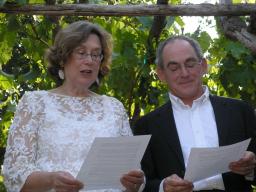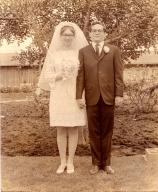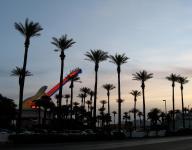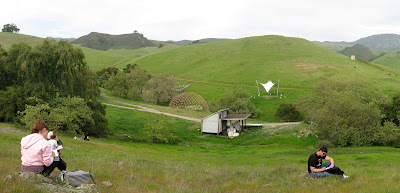Fortieth Wedding Anniversary Celebration
Sunday, April 29th, 2007
PROGRAM
Excerpt from “Mein Freund ist Mein,”
from Bach’s Cantata #140
Anniversary Pictures from 2007
S: Thank you all, friends and family, for joining us to honor our 40th wedding anniversary. The song you’ve just heard, a duet from Bach’s Cantata 140 based on the Biblical Song of Songs, was our wedding music. We want to take this moment to celebrate our blessings, especially our two children and four grandchildren. After 40 years of marriage, we want to celebrate that we are still in good health and still love each other.
J: We met just before the summer of love in 1966 and were married April 2, 1967 in our backyard in East Palo Alto . Rock and roll, tie dye and the war in Vietnam were raging. Those were the days of the generation gap. Both poor students, we had very little to spend on the wedding. It cost under $250, including the dress. Our parents arrived in Palo Alto to meet each other, and to meet the person their child was about to marry, for the first time, the day before the wedding.
S: We met several times with the minister, our friend Stuart McLean, to explore on the deepest inner level why we were founding a family with the world falling apart around us, to consider Christian and Jewish wedding ceremonies and, finally, to craft our own. We would like to share a few excerpts from that ceremony with you now:
S: We are assembled here in the presence of witnesses to join this man and this woman in marriage; to rejoice with them in the unity they have found; and to recognize that the vows between them made are a social as well as a private act. ¦
J: The act of marriage represents a change in relationship to the social order. It is the presentation of a new social unit to society and the founding of a family. As you who are gathered here symbolize this public world, Steven and Janet ask for and need your acceptance.
S: Nevertheless, while recognizing that community is the womb of life, and while affirming the importance of the social order, they are profoundly disturbed by the sickness of our society. In their higher commitment to our common humanity, they find that they must rebel against its dehumanization. Here they also, ask for your acceptance. Their commitment to one another is not just a private act, but a commitment to the concerns of all persons everywhere. Together they hope to give each other the comfort and courage both to affirm the social order and to change it…
J: The vision of our common humanity meets our past and embraces this present event of marriage. It is a public event, but more profoundly an act of two who hae decided in faith to become one. It is an act involving suffering as well as delight”conflict as well as love”despair as well as hope. Its form reveals the essence of true covenant. Within it two become one, but because of it, Steven’s and Janet’s unique individuality may grow.
S: Marriage is a moment of decision which is not just a moment in time, bujt one which transcends time, a moment in which Steven and Jan will always live. Its decision is a leap of faith. Its love takes the threat out of dying and growing old. Its promise changes the conditions of the future.
J: In the decision to live with and for one another, Steven and Janet have created a new relationship which involves all life. We all rejoice with you. ¦.
Wine ceremony”raise cups”these are words from our ceremony
S&J: This cup of wine is symbolic of the cup of life. As we share the one cup of wine, we undertake to share all that the future may bring. All the sweetness life’s cup may hold for you should be the sweeter because we drink it together. Whatever drops of bitterness it may contain should be less bitter because we share them.
S: And now in gratitude to all of you who’ve joined us today, some who were there with us 40 years ago, some who have traveled from as far away as Canada, we offer this toast. “May the close, loving bonds of each of us–to partners, family, friends, community and the earth itself–be strengthened and renewed today and every day.
___________
Some anniversary poems:

















